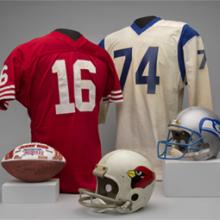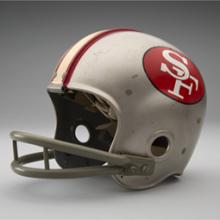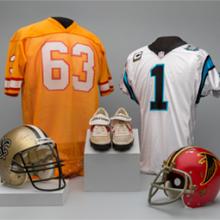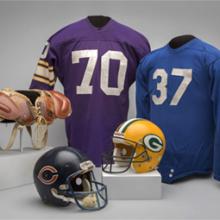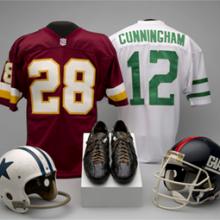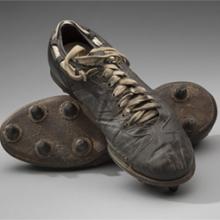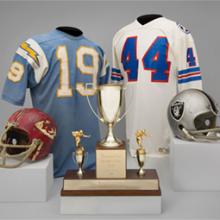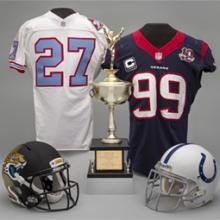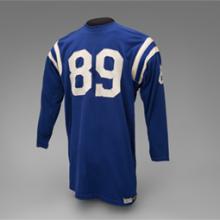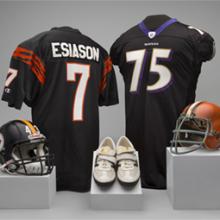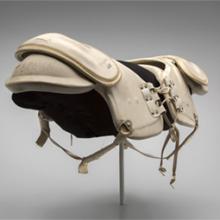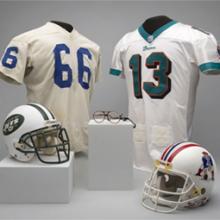The Nation’s Game: The NFL from the Pro Football Hall of Fame
The Nation’s Game: The NFL from the Pro Football Hall of Fame
Few could have imagined the phenomenal popularity of today’s National Football League (NFL) when representatives from four Ohio football clubs gathered nearly a century ago in Canton, Ohio, to establish a new standard of professional football. Although the game was popular with college teams and semi-professional clubs across the country, there was little press or fan interest outside of the league’s participating cities until the addition of star college players in the late 1920s. In the 1930s and 1940s, dynastic teams such as the Green Bay Packers and the Chicago Bears produced nationally known players whose celebrity further popularized the NFL. But many consider December 28, 1958, as the league’s watershed moment, when an estimated 45 million television viewers watched quarterback Johnny Unitas, in sudden-death overtime, lead his Baltimore Colts to a dramatic, come-from-behind victory over the New York Giants to win the NFL Championship.
The NFL was quick to recognize the value of television, which was in ninety percent of American households by the end of the 1950s. So too did a group of prospective owners who had been rebuffed in their attempts to secure NFL franchises. In 1960, they formed the rival American Football League and secured a five-year television contract with proceeds divided evenly among the clubs. The AFL gained immediate attention by signing many of the NFL’s first-round draft choices and raiding their teams for star players. In 1966, the leagues agreed to a merger with an annual interleague championship game, which became known as the Super Bowl.
In 1970, the NFL absorbed the AFL’s ten franchises and formed a balanced league of twenty-six teams in two separate conferences, with the winner of each conference meeting in the Super Bowl. The emerging prominence of this title game and the nationally televised broadcast of Monday Night Football brought professional football into the mainstream of American popular culture in the 1970s. In the following decades, the league added six expansion teams, gathering new fans in those respective cities and increasing numbers of fans who adopted NFL teams from across the country as their own.
Today, each NFL game attracts nearly 70,000 attendees, more than any other professional sports league. Professional football remains the nation’s favorite spectator sport by a large margin and its popularity shows no sign of abating. The Super Bowl has become a secular holiday for many Americans, and more than one million people are expected to attend the week-long festivities in the San Francisco Bay Area leading up to Super Bowl 50 on February 7, 2016. Regardless of which two teams face off at Levi’s® Stadium in Santa Clara, California, fans of the league’s other thirty teams will join more than 100 million television viewers in the United States and around the world to see who will be crowned as the next champions of America’s favorite game.
All objects and images on exhibition are presented Courtesy of the Pro Football Hall of Fame unless otherwise noted. Special thanks to Joe Horrigan, Executive Vice President Museums, Selection Process, and Chief Communications Officer, Pro Football Hall of Fame. Thanks also to the 49ers Museum presented by Sony; the Oakland Raiders; Dr. Paul Martin, and the Rippon Family Trust, for their generous participation in this exhibition.
About our exhibition partner
Since opening in 1963, the Pro Football Hall of Fame in Canton, Ohio, has been dedicated to honoring the heroes of the game, preserving its history, promoting its values, and celebrating excellence everywhere. Major expansion projects have transformed the Hall of Fame’s original 19,000 square-foot museum into an internationally recognized institution and travel destination with 118,000 square feet of interactive exhibit space. Today, the Hall of Fame is available outside of Canton through a variety of initiatives that include traveling exhibits, artifacts on loan, youth and educational outreach programs, and a dynamic website. Please visit www.profootballhof.com for more information.
Click here to view Kezar to Candlestick exhibition.
©2015 by the San Francisco Airport Commission. All rights reserved.
![New York Giants quarterback Frank Gifford rushes in the final minutes of regulation during the 23-17 overtime victory by the Baltimore Colts over the Giants in the NFL Championship Game December 28, 1958; Photo: Pro Football Hall of Fame]](/sites/default/files/NFL_desktop_hero.jpg)
